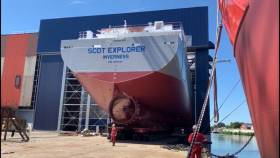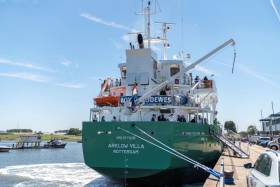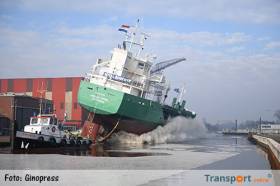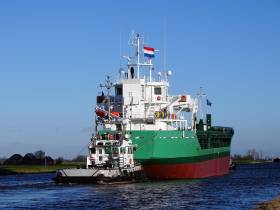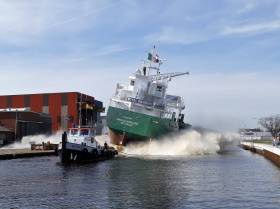Displaying items by tag: Royal Bodewes
Once again Arklow Shipping has had Dutch shipbuilder, Royal Bodewes launch an Eco-Trader of their 6,800dwt design series, writes Jehan Ashmore.
Arklow Resolve with a newbuild no. (NB: 825) at the Hoogezand yard, near Groningen, is were the launch on Friday took place at one of Bodewes three production sites. This newest Eco-Trader represents the fifth so far of seven of the series on order for the Irish client.
The morning transverse launch onto the Winschoterdiep Canal of the almost 105m multi-purpose dry-cargo ship with double side-skin construction, follows the 4,145 gross tonnes Arklow Ranger which as Afloat recently reported made its maiden sailing. This involved the 11 knot capable short-sea trader make a passage from Emshaven, Netherlands to within Norway's Arctic Circle.
As for the rest of the operational Eco-Traders/ R-class series, Arklow’s Rambler, Rally and 'leadship' Racer was launched in December, 2022 and was delivered to ASL almost a year ago, and was in service, starting with a maiden port of call to Spain.
When the two-hold Arklow Resolve is completed, the newbuild is to join the 38 Irish-flagged fleet that comprises Arklow Shipping Ltd. This in addition to 19 vessels that belong to Arklow Shipping Nederland B.V. based in Rotterdam.
Combined the fleet, mostly of short-sea traders that serve in northern Europe and bulk-carriers further overseas, total 57 dry-cargo ships. Of the bulk-carriers, this involves six M-class and two larger twins of the S-series.
A UK forest-products specialist which has operations including services to Irish Ports have ordered a third newbuild of the same design from a Dutch shipyard, writes Jehan Ashmore.
Scotline Marine Holdings Ltd confirmed the order from Royal Bodewes Shipyard of Hoogezand from where newbuilding (yard no.750) is to be named Scot Ranger. This is the same name used previously following the sale earlier last year of Scot Ranger which had seen this older tonnage discharge cargoes in Wicklow Port.
Scot Ranger follows the 4,800dwt Scot Carrier launched last year and Scot Explorer (pictured above) which is due to be completed in November 2019. The third newbuild has a delivery scheduled for the end of 2020.
According to Scotline although of the same design, Scot Ranger will be certified to ice class 1A, enabling passage within Swedish and Finnish waters. This makes the new addition to the fleet of 14 vessels ideal for the operator's liner services out of the Baltic.
The Romford in Kent based operator primarily runs liner services throughout northern Europe with regular routes between Sweden, Ireland, Denmark, Germany, Norway, the Baltic States and those serving the UK, Netherlands and France.
Also in Kent, the forest-products operater exclusively has terminals and an office in Rochester on the river Medway and another site located at Inverness, Scotland.
#Ports&Shipping - Another progressive chapter for Arklow Shipping was notably marked on Monday as the final of 10 newbuild short-sea traders was christened at a ceremony held in The Netherlands, writes Jehan Ashmore.
Arklow Villa was christened in Delfzijl, where glorious weather conditions added to the celebrations as the 86m long hulled vessel built by Royal Bodewes was named. The occasion saw the newbuild use the 'V' naming theme with the cargoship berthed along the quayside close to the Ems Estuary, shared with neighbouring Germany.
The ceremony took place five days after the start of sea-trails began in the North Sea. Prior to these trials, the newbuild like all 9 sisters since 2015, beginning with leadship Arklow Vale were launched at the inland yard in Hoogezand and then towed on the canal network to Delfzijl.
Arklow Villa joins ASL's Dutch division, Arklow Shipping Nederland B.V. and likewise to all the Bodewes Eco-Traders, they fly the Dutch flag and have Rotterdam as a port of registry. The introduction of the newbuild brings to more than 50 dry-cargo and bulk-carriers in the combined Dutch-Irish flagged fleet.
Afloat has carried out further research to astertain that the maiden commercial voyage by Arklow Villa also took place on the day of the naming ceremony. This involved the 2,999 gross tonnage newbuild make a departure from the Dutch north-east port to Porsgrunn, Norway.
It is from the southern Norwegian port that the Royal Bodewes 5,170dwt Eco-Trader an in-house design from the Dutch yard, is next to sail to Belfast Harbour. Afloat also notes that the inaugural call to the Northern Ireland port is estimated to take place on Saturday.
As for cargo operartions, the hold is fitted with portable bulkheads that can be placed in 8 positions for cargo separation and storage. The hatch deck is equipped with a Coops & Nieborg pontoon system.
A main engine comprises of a MaK 6M25 1740 kW where through a controllable pitch propeller delivers a speed of around 12.5 knots.
For in port handing and when within confined spaces the straight-stemmed bow designed to minimise wave impact for fuel efficiency, is equipped with an electric bowthruster of 300 kW.
ScotLine Orders Second Newbuild to Dutch Yard
#Ports&Shipping - Forest products operator Scotline Ltd whose vessels are regular callers to Irish east and south coast ports, have announced in partnership with a Dutch yard to exercise an option for a second newbuild of the 4785dwat Bodewes Trader design.
The newbuild's in-house design is from the yard of Royal Bodewes Group BV in Hoogezand where the cargoship is to be named MV Scot Explorer and launched in third quarter of 2019.
As previously reported on Afloat, the first newbuild MV Scot Carrier is currently under construction in Hoogezand with a launch expected to be in July and delivery in October 2018.
MV Scot Explorer will have a length of 89.98 meters and a beam of 15.20 meter and a maximum sailing draft of 5.68 meters. The newbuild will be powered by a MAK engine whilst being fully container fitted, with Swedish ice class 1B. When entering service the new ship will sail under the British Flag and classed under Lloyds Register.
The second newbuild will be a near-identical sister to MV Scot Carrier. Throughout the build of this first newbuild, both parties have had regular and open dialogue, looking at different ideas and concepts in order for the partnership to work well for both family-owned companies.
The MV Scot Explorer will be the next addition to Scotline’s fleet of 9 owned vessels, where we are looking to renew some of our older tonnage. Currently, Scotline has 15 ships in a fleet ranging from 1300dwcc to 4500dwcc, which gives a wide verity of scope for meeting customers’ varying needs.
Royal Bodewes Group which Afloat adds is located inland in the north-east of the Netherlands, employs 200 and has launched 450 ships since 1812. In modern times, Arklow Shipping have had numerous short-sea traders built at this waterway canal-side yard. Most recently, Arklow Villa launched a month ago was the final of 10 ships ordered that began in 2015 with the in-house 5,150dwat Eco-Traders series.
Since the shipyard began more than 200 years there have been many developments and this continues with innovation in their designs as well as being dynamic in workflow and building processes which the group is constantly striving for efficiency. To accomplish this, in 2014, a new production hall was built alongside the existing hall at the shipyard in Hoogezand, which was completed in January 2015, providing additional capacity.
Now Royal Bodewes Group is developing the yard by extending the two production halls to the waterfront and thus creating two construction sites meaning two ships can be built side by side. The infrastructure outside will also be improved. This is all done to enable Royal Bodewes to minimize congestion and provide the best service to their clients, both now and in the future. Construction of the production halls is expected to be completed in autumn 2019.
Forest Products Operator Orders Another Newbuild from Dutch Yard
#Ports&Shipping - Scotline which chiefly operates in Scandinavian forest products imports among those to Ireland, have announced the signing of a contract with a Dutch shipyard to build a 4,785dwt Bodewes trader.
The description of the newbuild refers to the yard of Royal Bodewes Group BV whose in-house design to build the short-sea trader comes with an option of a second vessel. The Scot Carrier is being built by the same yard as – and will be similar to – the Scot Leader which is a caller to Wicklow Port through local ship agency Conway Port.
Afloat adds among Scotline's network of liner services, the sailing schedule to Wicklow from Varberg, Sweden also includes calls to Belfast and Warrenpoint.
Scot Carrier and will have a length of 89.98 meters, a beam of 15.20 meter and a maximum sailing draft of 5.68 meters. She will be powered by a MAK engine and will sail under the UK flagand classed under Lloyds Register.
The hull is expected to be launched in September 2018 and we expect the finished vessel to be delivered in November 2018. She will be fully container fitted, with Swedish ice class 1B and will be built to comply with all the latest legislation including provisions to be ready for the Ballast Water Treatment regulations.
The Scot Carrier will be the most recent acquisition to Scotline’s fleet of 8 owned vessels. As also previously reported on Afloat, Scot Navigator was delivered last year as the start of our efforts to renew some of our older tonnage.
Scotline runs a fleet of coasters serving northern Europe with regular routes between Sweden, Ireland, Denmark, Germany, Norway, the Baltic States, the Netherlands, France and the UK. In addition to forest products, the operator handles bulk cargoes to project cargoes and many others.
With terminals in Rochester, England and Inverness, Scotland the operators fleet offer customers an all-in-one service of shipping, stockholding and distribution. The company also fixes market cargos for their vessels through use of the operators network of contacts worldwide.
Ninth Out of 10th Ship Takes on 'V' Name for Arklow's Dutch Newbuild Launched Today
#Ports&Shipping - The newest cargoship launched for Arklow Shipping took place this morning at the Dutch yard of Royal Bodewes which so far has completed eight sisters, writes Jehan Ashmore.
Arklow Viking, yard No. 729 was launched at 10.00hrs and forms the ninth out of 10 ordered of the Eco-Trader 5150 series designed in-house by the yard of Royal Bodewes. The inland yard in Hoogezand in located in the north-east of the Netherlands.
The Arklow Viking has a length overall (LOA) of 89m and likewise each of the sisters measure in at 2,999 gross registered tonnage. The figure though referred in the name of the 5150 series is that of deadweight total. Ships under this design series are also known as the 'V' class given the vessels begin with that letter. The previous sister was named Arklow Venus.
At the stern the Arklow Viking is given a port of registry in Rotterdam. The major port is where ASL's division in the Netherlands, Arklow Shipping B.V. is based.
The newbuild when completed will likewise take a repositioning journey along the canal network to Delfzijl. Invariably from there the new shortsea trader will be based for builders sea trials off Emshavn in the North Sea.
Ships from both the Irish and Dutch flagged fleet are commonplace in Irish and UK waters. In addition to trading throughout western Europe between Iberia and Scandinavia.
#Ports&Shipping - Arklow Venus, the newest ship of the fleet that was launched in October is currently undergoing sea trials on an estuary along the Dutch-German border, writes Jehan Ashmore.
The 89m Arklow Venus is part of the continues upgrading of Arklow Shipping ships. The new addition is the eight sister so far completed out of 10 placed on order of the 'V' class or Eco-Trader 5150 series designed in-house by the yard of Royal Bodewes. The figure refers to the cargoship's deadweight while gross tonnage is measured at 2,999.
Previously, the new short-sea trader had departed Bodewes inland shipyard at Hoogezand on Winschoterdiep Canal that links to the Eemskanaal Canal leading to Delfzijl on the Ems Estuary. As of this morning Arklow Venus made first contact with the salt waters of the Ems Estuary that has a border between The Netherlands and Germany.
The short sea trader that has a hold that can be divided for two bulk cargoes, headed out of the estuary towards the North Sea but remained within the the island archipelago of the Frisian Islands also known as the Wadden Islands.
Upon completion of sea trails the ship will join ASL's Dutch divison Arklow Shipping Nederland B.V. located in Rotterdam.
#ports&shipping - After a delay of a week, Arklow Venus which was constructed by Dutch yard Royal Bodewes was finally given the customary amidships launch yesterday, writes Jehan Ashmore.
The morning launch took place at 10.00 with the newbuild slidding off the stocks to enter the Winschoterdiep canal. Awaiting were a pair of tugs that already had mooring lines secured aft and fore so to guide the vessel safely away from the slipway to a nearby fit-out berth along the waterway. As routine the occasion in the yard was not open to the public.
As previously reported on Afloat, this 'Venus' revives the name of a predecessor but also marks the eight so far of 10 'V' class Eco-Trader 5150 newbuilds. The figure refers to the cargoship's deadweight while gross tonnage is measured at 2,999.
The 86m length overall short-sea multipurose trader has a single hold that can separated for two bulk cargoes. The new ship will join ASL's Dutch divison Arklow Shipping Nederland B.V.
Unlike the leadship Arklow Vale and earlier sisters, this latest newbuild has a revised straight stemmed bow. This design is also to reduce wave resistance and save on fuel consumption adding to greater efficiencies.
A main engine consists of a Mak 6M25C that will deliver a speed of around 12 knots.
As regards crew, each of the 9 seafarers will have their own private cabin with sanitary facilities and air-conditioning.
Vanguard's Lunchtime Launch for Arklow's Dutch Operations
#LunchLaunch - The final day of March marked the launch of yet another newbuild as part of an ongoing modernisation programme of the Arklow Shipping fleet, writes Jehan Ashmore.
Arklow Vanguard (yard no. 726) was given a lunchtime launch under glorious conditions. Turning out to see the spectacle were locals that were invited by the Dutch yard in Hoogezand. The 5,150dwat Bodewes Trader was given the customary sideways launch followed by wave splash that just added to the occasion.
The shipyard, Royal Bodewes has so far completed five of the ships under the ‘V’ naming series that began with launch of leadship Arklow Vale in 2015 (see video). With the launch of Arklow Vanguard, this marks the second half-way point as a total of 10 such cargoships are on order. They are to serve Arklow Shipping Nederland B.V. based in Rotterdam.
Among the bulk-dry cargoes that the near 87m long Arklow Vanguard is to transport will be grain, animal feed and steel rails.
Royal Bodewes has a long history in building sea-going vessels that began in 1912. The yard started constructing traditional shallow draught sailing barges, in Dutch known as "tjalks."
Almost a decade later saw the first motorized cargoships introduced. They offered 'for the time' a modern approach for both ocean going and inland water vessels. In addition these motorships with an optimized cargo hold met the wishes of the shipowners.
Second Splash As ASL Newbuild Takes First 'View' of the World
#SecondSplash - Arklow View was launched without official ceremony yesterday, despite this the second cargoship represents a significant order for Arklow Shipping as a further eight newbuilds are in the pipeline, writes Jehan Ashmore.
The absence of a traditional ship naming proceeding for yard no. 722 was according to Royal Bodewes to do with not disrupting the busy workload at the yard. It is also understood that the facility at Hoogezand, near Groningen was not open to the public, though outside of the yard on the canal edge excited onlookers clearly enjoyed the visual spectactcle as evident in the footage above.
Arklow View was built to the yard's own design, the Bodewes 5,100dwt Trader Series or 'V' class given the letter is used as the sisters naming theme. She is to join ASL's subsidiary Arklow Shipping Nederland B.V. located in Rotterdam.
It is almost three months to the day when leadship, Arklow Vale was launched with a traditional naming ceremony. On that occasion, she was christened with guests in attendence (see video from link above). This was followed with the customary smashing of a bottle on the bow.
On related matters the bow incorporate lines to minimise wave friction and consequently reduce on energy costs. The hull is 89 metres in length and the hold has a total capacity of 6258m3 / 221,000ft3.


























